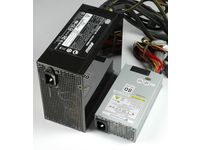Efficiency: Core 2 Nukes Atom On The Desktop
Conclusion
The results of our comparison between Intel’s Atom 230 and a Core 2 Duo E7200 with an efficient G31 platform were interesting, to say the least. We learned several things, which should be taken into consideration before purchasing a low-cost or low-power computer, as these things have a larger impact than the performance difference between the two machines. Let’s sum up the findings:
Beware Of Over-Doing It On Your Power Supply!
Purchasing an oversized power supply unit may look attractive as an investment for the future, but it is an issue if you want your system to be power efficient. Matching your power supply’s output to the real power requirement of the target system will make sure that the power supply operates at a load level at which it is truly efficient. If your power supply is extremely powerful, but operates at extremely low loads, then it will operate at very low efficiency and have the system require much more power than necessary. Selecting an appropriate power supply is the key, as it will help to reduce power waste much more than going for more efficient components!
Efficiency And Performance Per Watt
Atom 230 is extremely power-friendly, it’s tiny, and it’s very affordable. This is important for mobile devices, where requirements are limited. But Atom is not an efficient product if efficiency is defined by performance per watt or power. We found that the Core 2 Duo, in our case the model E7200, can be operated at an equally low idle power as the Atom 230 (less than 30 W total), while still delivering between 50% and up to several times more performance if you need it. The result is a performance-per-watt ratio that is substantially better for the Core 2 Duo.
Atom or Core 2?
Let’s get back to the key issue: does Atom make any sense for desktop-like PCs? It does, but only if you have to be very conservative on cost, and only if your requirements are clearly defined. Atom-based nettops or budget PC solutions are very affordable, but they don’t perform really well and you hardly have any upgrade possibilities. If you can afford spending $100 more for the motherboard and a decent processor, you’ll get a solution that offers similar idle power, but much better performance and efficiency, along with upgrade options.
Get Tom's Hardware's best news and in-depth reviews, straight to your inbox.
